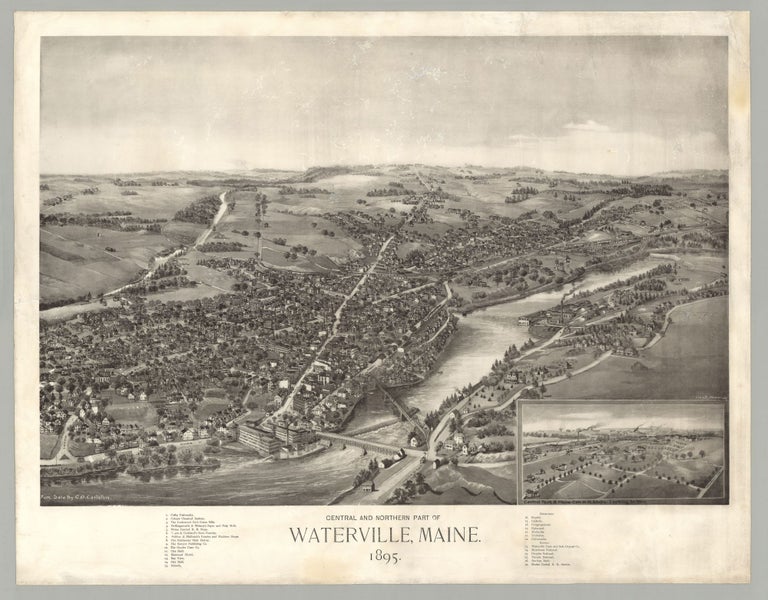Central and Northern Part of Waterville, Maine.
[Waterville?]: C. G. Carleton[?], 1895. Photolithograph, 17.875” x 26” plus margins. An uncommon bird’s eye view of Waterville, Maine, showing the central and northern part of town stretching along the western side of the Kennebec River, as well as a portion of the town of Winslow on the eastern side. This view shows the city from Sherwin Street on the left to the Maine Central Railroad Shops on the far right, with the commercial part of town in the center foreground. The most prominent structure in town, the Lockwood Company’s cotton mill, appears along the river near the convergence of Water Street and Main Street. This and twenty-six other buildings are listed in a numbered key in the title margin. Colby College, identified in the key as “Colby University,” consists of seven buildings situated between College Avenue and the Kennebec, its location before moving to Mayflower Hill on the west side of town in the 1930s . On the Winslow side, opposite Colby, are Hollingsworth & Whitney’s Paper and Pulp Mills, whose unpleasant emissions contributed to the Colby move. An inset close-up view in the lower right corner depicts “Central Park & Maine Cen-RR Shops. Looking So. West.”
A credit appearing in the lower left corner of the image reads “For sale by C. G. Carleton.” This would be Charles G. Carleton (c. 1835-1895) who was active in Waterville as a bookseller and photographer from 1862 to circa 1889. The post-1889 city directories list him as an auctioneer/merchant. The publication of this print appears to have been one of his commercial endeavors.
George E. Norris (1855-1926), a resident of Brockton, Massachusetts, began his career as a publisher of bird’s eye views in 1882 in partnership with Albert F. Poole, publishing some ten New Hampshire views drawn by Poole in their first year of operation together. In 1884 he began working with Henry Wellge, producing approximately fifty views through 1886, most drawn by Wellge but a few likely drawn by Norris. In 1887 he began publishing under his own name alone, using the Burleigh Litho. Establishment of Troy, New York as his printer. Most of these views he drew himself. Reps credits Norris with 135 views. We have handled another view by Norris unrecorded by Reps, Littlejohn’s and Cousin’s Islands, Casco Bay, Maine (1898), bringing the total number of Norris views to 135, and showing that he was active a year longer than Reps suggests.
Reps records just one copy, at the Waterville Historical Society. OCLC records a copy at the now defunct American Textile History Museum.
REFERENCES: Reps, John. Views and Viewmakers of Urban America, #1257 and pp. 193-194 (for Norris biography); Podmaniczky, Christine B. and Earle Shettleworth. Through a Bird’s Eye: Nineteenth-Century Views of Maine, p. 34; Last, Jay. The Color Explosion : Nineteenth-Century American Lithography (Santa Ana, CA, 2005), p. 44; Charles G. Carleton, Photographer, Waterville, Maine at laurelcottagegenealogy.com.
CONDITION: Some surface loss in sky and a few small surface losses to landscape, light stains to margins.
Item #6394
Sold


